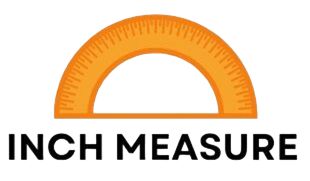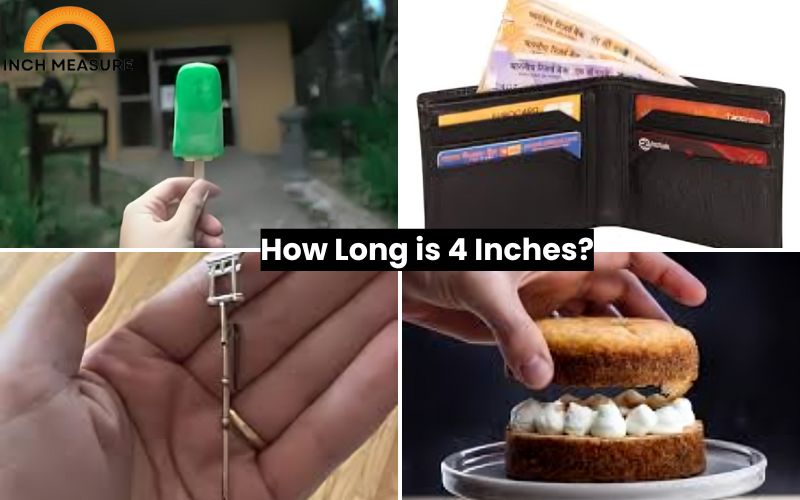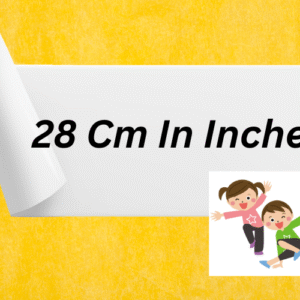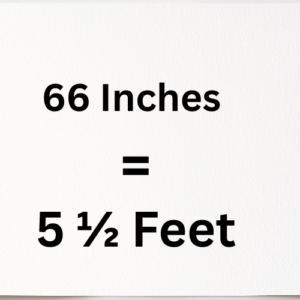How long is 4 inches? Ever wondered what that measurement really looks like, or how to eyeball it without a ruler? You’re in the right spot! Four inches is a handy, everyday length—think the width of your phone or the size of a big cookie—that shows up in cooking, crafting, DIY projects, and more.
In this article, we’ll break it down simply: conversions to centimeters and feet, quick comparisons to familiar objects, and tips to visualize it easily. Plus, discover 15 common household items that measure exactly 4 inches, with fun descriptions to help you measure anything accurately next time. No more guessing—let’s make 4 inches crystal clear!
What Is an Inch?

An inch is a unit of length in the imperial and United States customary systems of measurement. It is defined as exactly 2.54 centimeters in the metric system, a standard established by international agreement in 1959. The inch is commonly used in countries like the United States, the United Kingdom, and Canada for everyday measurements, such as the dimensions of objects, heights, and distances.
To understand 4 inches, we first recognize that it is four times the length of a single inch, or 4 × 2.54 cm = 10.16 centimeters. This precise conversion allows us to compare 4 inches to other units of measurement and visualize its length in practical terms. Four inches is a relatively small length, but it is significant in many contexts, from crafting and construction to technology and design.
The Historical Context of the Inch
The inch has a rich history dating back to ancient times. The term “inch” is derived from the Latin word uncia, meaning “one-twelfth,” as an inch was originally defined as one-twelfth of a foot. In medieval England, the inch was sometimes defined as the width of a man’s thumb at the base of the nail, though this varied from person to person. Over time, standardization became necessary to ensure consistency in trade, engineering, and science.
In 1959, the international yard was defined as exactly 0.9144 meters, and the inch was standardized as 2.54 centimeters. This agreement unified measurements across countries using the imperial system and facilitated conversions to the metric system. Understanding this historical evolution helps contextualize why 4 inches, as a precise measurement, is relevant in modern applications.
Visualizing 4 Inches
To grasp the length of 4 inches, it’s helpful to compare it to familiar objects or units. Four inches is approximately the length of a standard smartphone’s width, the diameter of a small dessert plate, or the height of a stack of about 40 standard playing cards. It’s a length that fits comfortably in the palm of your hand, making it relatable and easy to estimate in everyday scenarios.
For those more familiar with the metric system, 4 inches is just over 10 centimeters, or 101.6 millimeters. This is roughly the length of a short ruler or the width of a large index card. Visualizing 4 inches in these terms helps bridge the gap between imperial and metric systems, making the measurement accessible to a global audience.
Conversion Table for 4 Inches
To provide clarity, the following table converts 4 inches into various units of measurement:
| Unit | Equivalent to 4 Inches |
| Centimeters | 10.16 cm |
| Millimeters | 101.6 mm |
| Feet | 0.333 ft |
| Meters | 0.1016 m |
| Yards | 0.111 yd |
| Kilometers | 0.0001016 km |
This table illustrates the versatility of 4 inches across different measurement systems, highlighting its relatively small but practical size.
Practical Applications of 4 Inches
Four inches is a common dimension in various fields, including construction, design, technology, and everyday life. Here are some examples of where 4 inches is relevant:
- Construction and Carpentry: In woodworking, 4-inch boards (often referred to as 4x4s) are used for structural supports, such as posts or beams. The actual dimensions may vary slightly due to milling, but the nominal size is 4 inches.
- Technology: Many smartphones and small electronic devices have screens or components that measure approximately 4 inches diagonally or in width.
- Crafts and Sewing: In sewing, 4-inch fabric strips are commonly used for quilting or creating decorative borders.
- Everyday Objects: Many household items, such as tools, utensils, or personal accessories, are designed with 4-inch dimensions for ergonomic or functional purposes.
The versatility of 4 inches makes it a measurement worth understanding in detail, as it appears frequently in both professional and personal contexts.
Related Post: How Long Is 6 Inches?
15 Everyday Items That Are 4 Inches Long
To make the concept of 4 inches more tangible, we’ll explore 15 everyday items that are approximately 4 inches long.
1. Standard Smartphone

Smartphones have become ubiquitous, and many compact models have a width or height close to 4 inches. For example, older models like the iPhone 5S or some budget Android phones have a screen size or body width of approximately 4 inches. This makes them easy to hold and operate with one hand, a design choice that prioritizes ergonomics.
The 4-inch dimension in smartphones is significant because it balances portability with usability. A 4-inch screen provides enough space for clear text and visuals without making the device bulky. For users with smaller hands or those who prefer lightweight phones, a 4-inch device is ideal. Additionally, the width of many modern smartphones, even those with larger screens, hovers around 4 inches, making this measurement a standard in the tech industry.
Historically, the 4-inch screen size was a sweet spot for early smartphones, offering a compromise between the smaller screens of feature phones and the larger displays of tablets. Even today, some manufacturers produce compact phones with 4-inch dimensions to cater to users who value simplicity and portability. Beyond the device itself, accessories like phone cases or screen protectors are often designed to fit these 4-inch dimensions, further emphasizing the measurement’s relevance.
In practical terms, a 4-inch smartphone fits comfortably in a pocket or small bag, making it a convenient choice for on-the-go use. The tactile experience of holding a 4-inch device feels natural, as it aligns with the average hand size. This measurement also influences app design, as developers optimize interfaces for 4-inch screens to ensure accessibility across devices.
2. Credit Card

A standard credit card measures approximately 3.375 inches by 2.125 inches, but when considering its diagonal length, it comes close to 4 inches (approximately 4.01 inches). For simplicity, we’ll treat the diagonal as a practical example of a 4-inch length, as it’s a measurement people encounter daily.
Credit cards are essential in modern transactions, and their compact size is designed for convenience. The near-4-inch diagonal ensures the card fits easily into wallets, cardholders, and payment terminals. This dimension is standardized globally under the ISO/IEC 7810 ID-1 standard, ensuring compatibility across financial systems.
The 4-inch diagonal also contributes to the card’s durability and usability. A card that’s too large would be cumbersome, while one too small might be difficult to handle or read. The 4-inch measurement strikes a balance, allowing for clear printing of card numbers, names, and security features like chips or magnetic strips. Additionally, the card’s size makes it easy to store in stacks, such as in a wallet’s card slots, which are often designed to accommodate this dimension.
In everyday life, people interact with credit cards multiple times a day, whether at stores, online, or ATMs. The 4-inch diagonal is a subtle but critical aspect of the card’s design, ensuring it’s both functional and portable. This measurement also influences related products, such as card readers or protective sleeves, which are tailored to fit the card’s dimensions.
3. Standard Butter Stick

In the United States, a standard stick of butter measures approximately 4 inches in length. This dimension is consistent across most brands, making it a familiar example of a 4-inch object in the kitchen.
Butter sticks are packaged in a rectangular prism shape, with a length of 4 inches, a width of about 1.5 inches, and a height of about 1 inch. This size is designed for convenience in cooking and baking, as it aligns with standard measurements in recipes (e.g., one stick equals 1/2 cup or 8 tablespoons). The 4-inch length makes the stick easy to handle, whether cutting it into tablespoons or unwrapping it for use.
The 4-inch butter stick is a staple in American kitchens, and its size has practical implications. For example, butter dishes and storage containers are often designed to accommodate this length, ensuring a snug fit. The measurement also facilitates portion control, as recipes often call for fractions of a stick, which can be easily measured by cutting along the 4-inch length.
Beyond cooking, the butter stick’s 4-inch dimension is a useful reference for visualizing measurements in other contexts. For instance, someone without a ruler might estimate 4 inches by comparing an object to a butter stick. This relatability makes the butter stick an excellent example of how measurements are embedded in everyday life.
4. Pocket Comb

A standard pocket comb, often used for grooming hair, is typically around 4 inches long. This compact size makes it portable and convenient for carrying in a pocket, purse, or travel bag.
Pocket combs are designed with functionality in mind. The 4-inch length allows for a sufficient number of teeth to comb through hair effectively while keeping the tool small enough for daily use. The comb’s size also ensures it fits comfortably in the hand, providing good grip and control during grooming.
The 4-inch dimension is particularly common in men’s grooming products, where compact combs are marketed for quick touch-ups. Women’s combs may vary in size, but many travel-sized or foldable combs also adhere to this length. The material of the comb—whether plastic, metal, or wood—does not significantly alter its 4-inch length, as this dimension is optimized for portability.
In addition to personal grooming, pocket combs have cultural significance. For example, they are often featured in barber shops or as part of grooming kits, where their 4-inch size ensures they are practical for both professional and personal use. The comb’s length also makes it a handy tool for estimating small measurements in a pinch.
5. Large Paperclip

A large paperclip, often used to secure thick stacks of paper, is approximately 4 inches long when unfolded. While standard paperclips are smaller, jumbo or oversized versions reach this length, making them a useful example.
Paperclips are simple yet versatile tools, and the 4-inch length of a large paperclip allows it to hold together substantial documents or serve as an impromptu tool for other tasks, such as unlocking small mechanisms or organizing cables. The unfolded length is particularly relevant, as it provides a straight, measurable segment that aligns with 4 inches.
The design of a 4-inch paperclip reflects its utility. Made from a single piece of wire bent into loops, the paperclip’s length ensures it can grip multiple sheets without slipping. This size also makes it easy to store in desk organizers or drawers, where it can be quickly accessed when needed.
In office settings, large paperclips are less common than their smaller counterparts but are valued for their strength and versatility. The 4-inch length also makes them a handy reference for estimating measurements in environments where rulers or tape measures are unavailable.
6. Standard Teaspoon

A standard teaspoon, used for measuring ingredients or stirring beverages, is often around 4 inches long, including the handle and bowl. This length is typical for everyday cutlery found in most households.
The 4-inch teaspoon is designed for both functionality and ergonomics. The bowl of the spoon is sized to hold approximately 5 milliliters (1 teaspoon) of liquid or dry ingredients, while the 4-inch handle provides enough length for a comfortable grip. This makes the teaspoon ideal for tasks like stirring coffee, measuring spices, or serving small portions.
In the kitchen, the 4-inch teaspoon is a staple for both cooking and baking. Its size ensures precision in recipes, where even small variations in ingredient quantities can affect the outcome. The teaspoon’s length also makes it easy to store in cutlery drawers or utensil holders, where it fits alongside other spoons and forks.
Beyond the kitchen, the teaspoon’s 4-inch length is a useful reference for estimating measurements in other contexts. For example, someone might compare an object’s length to a teaspoon to gauge whether it’s approximately 4 inches. This relatability enhances the teaspoon’s value as an everyday example.
7. Small Pocket Knife

A small pocket knife, often used for camping, crafting, or everyday tasks, typically has a blade or overall length of about 4 inches when folded. This compact size makes it portable and versatile.
Pocket knives are designed for practicality, and the 4-inch length ensures they can be carried in a pocket or bag without being cumbersome. The blade itself may be slightly shorter, but the overall length, including the handle, often reaches 4 inches, making it a fitting example.
The 4-inch pocket knife is popular among outdoor enthusiasts, crafters, and anyone needing a compact cutting tool. Its size allows for precise cuts while remaining safe to carry when folded. The handle is ergonomically designed to fit the hand, and the 4-inch length ensures it’s neither too large nor too small for most tasks.
In addition to its practical uses, the pocket knife’s 4-inch length makes it a recognizable reference for measurements. For example, someone might use a pocket knife to estimate 4 inches when measuring materials for a project. This versatility makes it a valuable example in this context.
8. Standard USB Flash Drive

A standard USB flash drive, used for data storage and transfer, is often around 4 inches long, including the protective cap. This size is common for both consumer and professional models.
The 4-inch length of a USB flash drive is designed for portability and ease of use. It’s small enough to fit in a pocket or attach to a keychain but large enough to handle comfortably when plugging into a computer or device. The length also accommodates the internal components, such as the memory chip and USB connector, while leaving room for a protective casing.
USB flash drives with a 4-inch length are widely used for transferring files, backing up data, or installing software. Their size makes them convenient for both personal and professional use, as they can be easily stored or transported. The 4-inch dimension also ensures compatibility with USB ports, which are spaced to accommodate devices of this size.
In everyday scenarios, a USB flash drive’s 4-inch length is a practical reference for estimating measurements. For example, someone might compare an object to a flash drive to determine if it’s approximately 4 inches long. This relatability enhances its value as an example.
9. Small Notepad

A small notepad, often used for jotting down quick notes or lists, is typically around 4 inches in height or width. This compact size makes it ideal for carrying in a pocket or purse.
The 4-inch notepad is designed for convenience, providing enough space for writing while remaining portable. Many notepads, such as those used for grocery lists or reminders, adhere to this dimension, making them a common sight in offices, homes, and classrooms.
The 4-inch length also influences related products, such as notepad holders or binders, which are designed to accommodate this size. The notepad’s compact dimensions make it easy to store in desk drawers or bags, ensuring it’s always accessible when needed.
In addition to its practical uses, the 4-inch notepad is a useful reference for visualizing measurements. For example, someone might compare an object’s length to a notepad to estimate 4 inches. This relatability makes the notepad a valuable example in this context.
10. Standard Keychain

A standard keychain, used to hold keys or small accessories, is often around 4 inches long, including the chain and any attached fobs. This length is common for both decorative and functional keychains.
The 4-inch keychain is designed for portability, allowing it to fit comfortably in a pocket or bag. The length ensures it can hold multiple keys while remaining manageable. Many keychains also include additional features, such as small tools or charms, which contribute to the overall 4-inch length.
In everyday life, keychains are a constant companion, used to organize keys for homes, cars, or offices. The 4-inch length makes them easy to handle and locate, even in a crowded bag. The dimension also ensures compatibility with key holders or organizers, which are designed to accommodate this size.
The keychain’s 4-inch length is also a practical reference for estimating measurements. For example, someone might use a keychain to gauge whether an object is approximately 4 inches long. This relatability enhances its value as an example.
11. Small Ruler

A small ruler, often used for quick measurements in school or office settings, is typically 4 inches long. This compact size makes it portable and convenient for everyday use.
The 4-inch ruler is designed for precision, with markings in inches, centimeters, or millimeters. Its length makes it ideal for measuring small objects, such as paper, fabric, or craft materials. The ruler’s compact size also ensures it fits easily in pencil cases or desk drawers.
In educational settings, 4-inch rulers are often included in geometry kits or school supplies, as they are easy for children to handle. The length is sufficient for basic measurements while remaining safe and portable. In professional settings, such as design or crafting, a 4-inch ruler is a handy tool for quick tasks.
The ruler’s 4-inch length is also a direct reference for the measurement itself, making it an ideal example. Someone can visualize 4 inches simply by picturing a small ruler, reinforcing the measurement’s tangibility.
12. Standard Lip Balm Tube

A standard lip balm tube, used for moisturizing lips, is typically around 4 inches long, including the cap. This size is common for popular brands like ChapStick or Burt’s Bees.
The 4-inch lip balm tube is designed for portability, fitting easily in a pocket, purse, or cosmetic bag. The length ensures it’s easy to hold and apply while accommodating enough product for regular use. The tube’s design also includes a twist mechanism, which contributes to the overall 4-inch length.
Lip balm tubes are a staple in personal care, used by people of all ages to prevent dry or chapped lips. The 4-inch size makes them convenient for travel or daily carry, ensuring they’re always accessible when needed. The dimension also influences packaging, as lip balm displays or organizers are designed to accommodate this size.
The lip balm tube’s 4-inch length is a practical reference for estimating measurements. For example, someone might compare an object to a lip balm tube to gauge whether it’s approximately 4 inches long. This relatability enhances its value as an example.
13. Small Flashlight

A small flashlight, often used for emergencies or outdoor activities, is typically around 4 inches long. This compact size makes it portable and easy to carry.
The 4-inch flashlight is designed for convenience, providing enough light for small tasks while fitting in a pocket, glove compartment, or backpack. The length accommodates the battery, bulb, and housing, ensuring functionality without excessive bulk.
In everyday scenarios, a 4-inch flashlight is useful for tasks like navigating in the dark, checking under furniture, or camping. Its size makes it easy to store and access, and the 4-inch length ensures it’s comfortable to hold. The dimension also influences related products, such as flashlight holders or keychain attachments, which are designed to accommodate this size.
The flashlight’s 4-inch length is a practical reference for estimating measurements. For example, someone might use a flashlight to gauge whether an object is approximately 4 inches long. This relatability enhances its value as an example.
14. Standard Marker

A standard marker, used for writing or drawing, is often around 4 inches long, including the cap. This size is common for both permanent and dry-erase markers.
The 4-inch marker is designed for ergonomics, providing enough length for a comfortable grip while remaining portable. The size ensures it fits in pencil cases, desk organizers, or pockets, making it accessible for school, office, or home use.
Markers with a 4-inch length are versatile, used for tasks like labeling, highlighting, or creating art. The dimension accommodates the ink reservoir and tip, ensuring consistent performance. The marker’s size also makes it easy to store in bulk, such as in classroom supplies or office drawers.
The marker’s 4-inch length is a practical reference for estimating measurements. For example, someone might compare an object to a marker to gauge whether it’s approximately 4 inches long. This relatability enhances its value as an example.
15. Small Screwdriver

A small screwdriver, often used for precision tasks like repairing electronics or assembling furniture, is typically around 4 inches long, including the handle and shaft. This compact size makes it versatile and portable.
The 4-inch screwdriver is designed for tasks requiring precision, such as tightening small screws in glasses, electronics, or toys. The length ensures a good balance between control and leverage, making it effective for detailed work. The handle is ergonomically shaped to fit the hand, and the 4-inch size ensures it’s easy to store in toolkits or drawers.
In DIY projects or repairs, a 4-inch screwdriver is a go-to tool for small tasks. Its size makes it ideal for travel kits or emergency repairs, as it can be easily carried without taking up much space. The dimension also influences tool organizers, which are designed to accommodate this size.
The screwdriver’s 4-inch length is a practical reference for estimating measurements. For example, someone might use a screwdriver to gauge whether an object is approximately 4 inches long. This relatability enhances its value as an example.
Additional Comparisons and Contexts
Beyond everyday items, 4 inches can be compared to natural and biological references. For example:
- Human Anatomy: The average width of an adult’s palm is approximately 4 inches, making it a natural reference for estimating this length.
- Nature: Many small animals, such as certain species of fish or rodents, have a body length of around 4 inches, providing a biological context.
- Sports: In sports like baseball, the diameter of a baseball bat’s grip is often close to 4 inches, influencing design and performance.
These comparisons further illustrate the versatility of 4 inches as a measurement, bridging human, natural, and technical contexts.
Table of 4-Inch Items and Their Uses
To summarize the everyday items, the following table lists each item and its primary use:
| Item | Primary Use |
| Smartphone | Communication, browsing, apps |
| Credit Card | Financial transactions |
| Butter Stick | Cooking, baking |
| Pocket Comb | Grooming hair |
| Large Paperclip | Securing documents, organization |
| Teaspoon | Measuring, stirring |
| Pocket Knife | Cutting, outdoor tasks |
| USB Flash Drive | Data storage, transfer |
| Small Notepad | Note-taking, lists |
| Keychain | Organizing keys |
| Small Ruler | Measuring small objects |
| Lip Balm Tube | Lip moisturizing |
| Small Flashlight | Illumination in dark areas |
| Standard Marker | Writing, drawing, labeling |
| Small Screwdriver | Precision repairs, assembly |
This table provides a quick reference for the practical applications of 4-inch items, reinforcing their relevance in daily life.
Why 4 Inches Matters
The 4-inch measurement is significant because it represents a practical, human-scale length that appears frequently in design, manufacturing, and everyday objects. Its versatility makes it a common dimension for tools, accessories, and devices, ensuring functionality and portability. Understanding 4 inches also facilitates conversions between imperial and metric systems, which is essential in a globalized world where both systems are used.
In education, teaching children about 4 inches through familiar objects like rulers or smartphones helps them develop a sense of measurement. In professional fields, such as engineering or architecture, 4 inches is a precise dimension that influences design decisions. Even in creative pursuits, like art or crafting, 4 inches is a manageable size for detailed work.
You May Also Need To Know: how long is 3 meters
FAQs
How can I estimate 4 inches without a ruler?
You can estimate 4 inches by comparing an object to everyday items like a credit card’s diagonal (about 4 inches), a butter stick, or the width of your palm. These familiar references provide a quick way to visualize the length without measuring tools.
Why is 4 inches a common dimension for objects?
Four inches is a practical size that balances functionality and portability. It’s small enough to fit in pockets or hands but large enough to serve various purposes, such as cutting, measuring, or holding. This makes it a popular choice in design and manufacturing.
How does 4 inches compare to metric measurements?
Four inches is exactly 10.16 centimeters or 101.6 millimeters. This conversion is useful for those familiar with the metric system, allowing them to visualize 4 inches as slightly longer than 10 centimeters.
Are there cultural differences in using 4 inches as a measurement?
In countries using the metric system, 4 inches (10.16 cm) may be less intuitive, as centimeters are the standard. However, global trade and technology mean that 4-inch measurements, like smartphone screens, are universally recognized, bridging cultural differences.
Conclusion
4 inches is a measurement that shapes the design of countless objects we interact with daily. By exploring its conversions, visualizing it through familiar items, and understanding its significance in various fields, we gain a deeper appreciation for this seemingly simple length. Whether you’re measuring a tool, designing a product, or simply curious about the world around you, 4 inches is a measurement that connects the abstract to the tangible, making it a cornerstone of our physical understanding.
Explore Our Calculators Tools to Measure More Lengths..
Convert Inches to Meters, cm, mm, and Feet
Converted Values:
Meters (m): 1.016
Centimeters (cm): 101.60
Millimeters (mm): 1016.00
Feet (ft): 3.33





